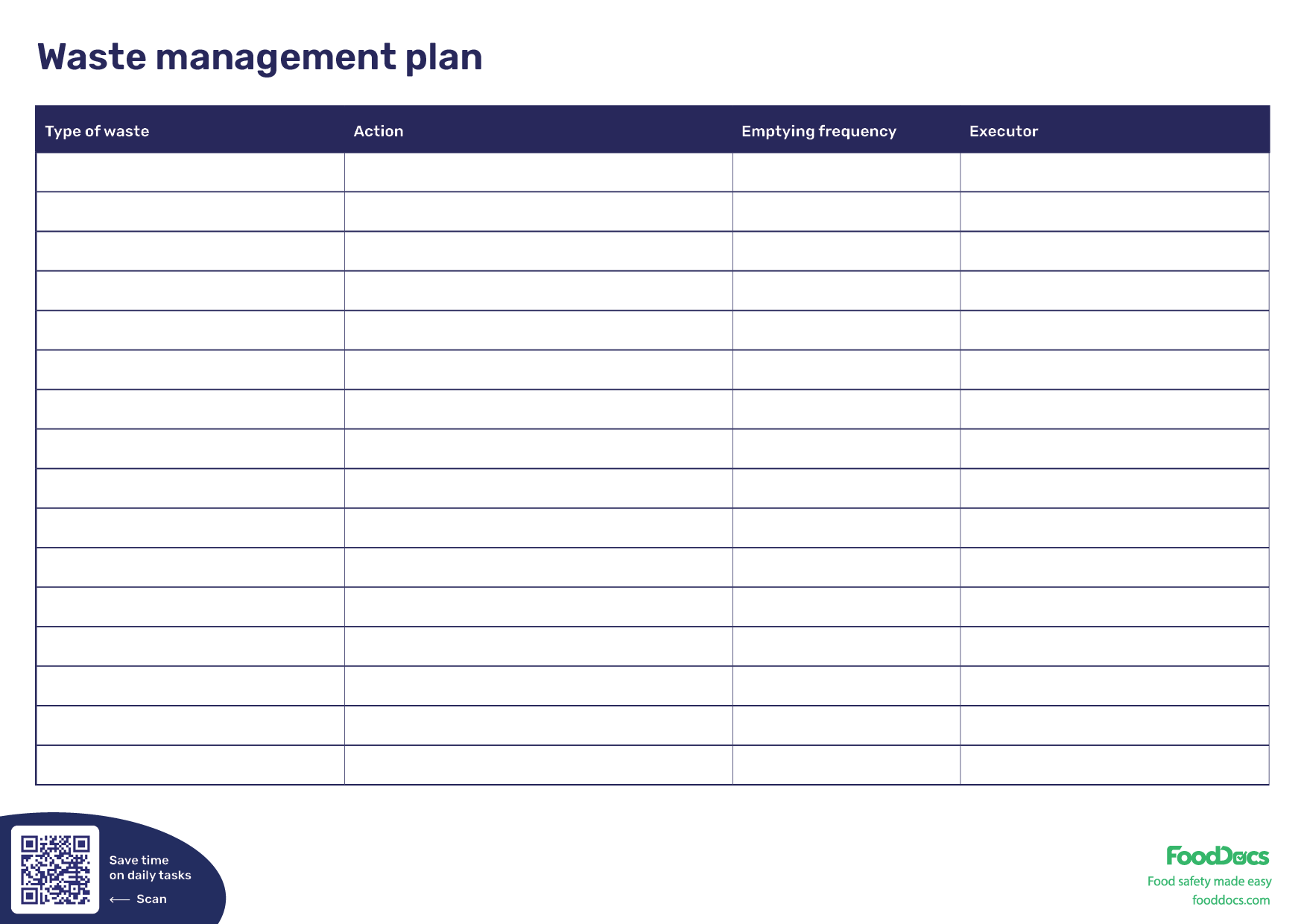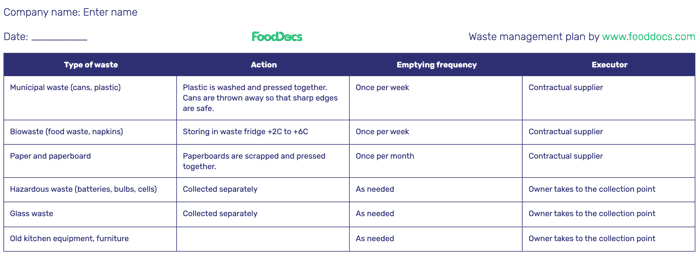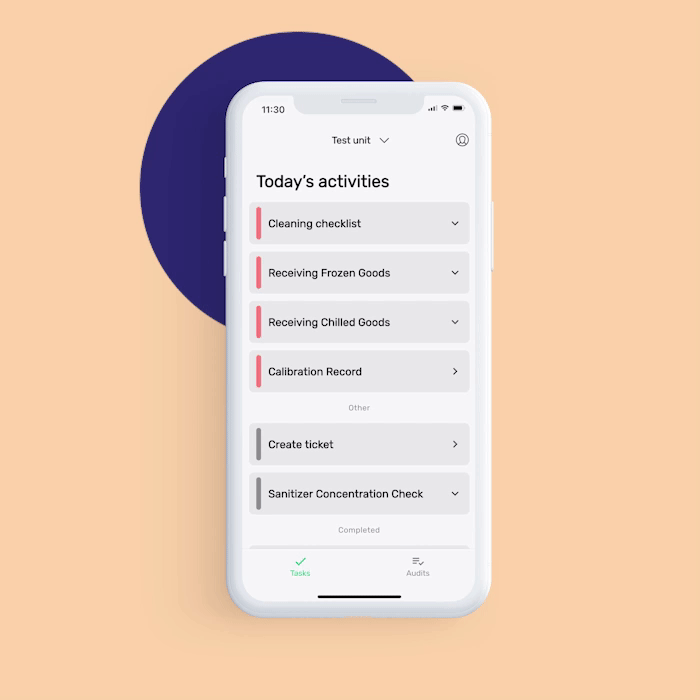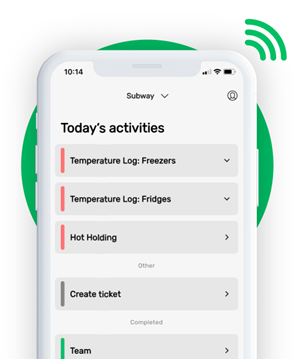WASTE MANAGEMENT PLAN TEMPLATE | FREE DOWNLOAD


This is how our Digital Food Safety platform saves 20% of your time on daily tasks:
- Get upcoming task notifications
- Add data into the app
- Check the status of tasks in real-time

When food safety was still handled on paper, I typically spent a couple of hours per day getting the papers and going around checking or completing tasks… Now I can sit down and it's just all there in one place. It takes me 5-10 minutes.
Ruth B.
Store Manager
Key points covered:
- A Waste Management Plan plays an important role in the HACCP plan of every food business.
- Waste control covers the list of activities to ensure food safety, the frequency of waste disposal, and who is responsible for it.
- When waste bins are not correctly stored, they risk physical contamination of food and may attract pests.
- Following good industry practices is a legal requirement and helps protect both the environment and customers from foodborne illnesses.
- Types of waste include biowaste, cardboard and paper, glass waste, metal waste recycling, and general waste.
- Keep in mind that when storing biowaste, keep it in a waste fridge to prevent parasites.
- Always collect glass waste and hazardous waste separately from other waste.
- Your HACCP plan must include a chapter on waste management with a detailed risk analysis which covers storage space and storage containers.
- Set a team who is responsible for a waste management and train them periodically. The team can consist of one or more people.
- Your waste management documentation should include clear instructions on how to prevent it, how you can keep waste in check, and what to do when waste-related food safety incidents occur.
- FoodDocs' Food Safety Management software helps food businesses maintain clean facilities and stay compliant with digital cleaning checklists, logs, and more!
How to create a Waste Management Plan for your food business?
Waste Management Plan is a must and plays an important role in the HACCP plan of every food business, whether a restaurant, cafe, or hotel. The waste control covers everything related to waste management in your company and how food safety is ensured together with environmental sustainability. This includes the list of waste, activities to ensure food safety, the frequency of waste disposal, and who is responsible for it. When waste bins are not correctly stored, they risk physical contamination of food and may attract pests.
It is a legal requirement to follow good industry practices and protect the environment and customers from foodborne illnesses. Keep your team always aware of the waste control plan to ensure that all waste is disposed of properly in accordance with relevant legislation.
To put an efficient waste schedule together, consider the following:
- Types of waste
- Quantity of bins required
- Designated areas for the bins
- Moving routes
An efficient waste control plan requires careful planning and preparation. In this article, we go through each step of the waste management planning process. Our aim is to help you create a waste plan that works for your business. In this article, you will find a waste management template that will help you put your waste schedule together and identify what action plan is required to allocate responsibilities accordingly.
If you are looking to organize a successful waste management system, sign up for FoodDocs. You can find the easiest and quickest way to build your HACCP plan along with a waste schedule. In addition to the waste schedule, you can download our free HACCP plan template and other resources from our food safety template hub. Go and check out the most needed ones.
STEP 1: Types of waste
To start creating your waste management plan, think through what different types of waste you have or produce and how you will separate and collect it.
Types of wastes that are required to collect separately in a restaurant:
- Biowaste. This bin is meant for both - for Pre-Consumer Food Waste and Post-Consumer Waste.
- Pre-consumer waste is generated during the preparation of any dish or beverage within the restaurant, cafe, or store. It is any spoiled, expired, improperly cooked, or dropped food. It might be raw food products such as potato peel or roots from vegetables or trimming the fat or part off of a piece of chicken.
- Post-Consumer Food Waste is produced by the consumers. It comes from food and leftovers customers leave on plates to be thrown away by restaurants.
- Cardboard and paper. Keep all recyclable materials separately, including cardboard. Here, it’s also important to keep in mind that your team scraps and presses the cardboard together before putting it into the bin. You'll also save space in your rooms like this.
- Glass waste. Always collect recycled glass separately.
- Metal waste recycling. Collect cans containing ingredients also separately for recycling purposes.
- General waste bin. Put all other general waste that is not recyclable or repurposable in a designated bin. However, it is important to educate your team members on what can and cannot be recycled, to reduce the amount of recyclable waste going to improper places.
To make it easier for your team to keep track of which rubbish should go where, label bins accordingly.

STEP 2: Preventive actions in waste management and emptying frequency
Think about the actions and how often they need to be done according to the waste schedule. For example, always wash and press together things like plastic, and throw away cans so that sharp edges are safe. Also, keep in mind to store biowaste in a waste fridge to keep away parasites. Collect glass waste and hazardous waste always separately from other waste.
The content of your HACCP plan must include a chapter on waste management with a detailed risk analysis. Your risk analysis must include storage space, storage containers, and waste management.
For example, waste storing containers have a risk of harmful bacteria growth due to contamination.
Prevention? Make sure your waste containers are in a sound condition and easy to clean. Keep your 'waste container' cleaning schedule with the main cleaning schedule. Make sure you only use waste containers labeled correctly, made from sound, non-toxic material, and are covered with a tight-fitting lid.
Train your team on how to handle waste and keep the premises clean, introduce a cleaning schedule and cleaning checklists. Always collect biowaste in the waste fridge.
STEP 3: Set a team who is responsible for a waste management
Depending on the restaurant's capacity and scope, the team may consist of one or more persons. It would be best if these people were involved in the food preparation because they know the job the best. On the other hand, the team is familiar with the type and quantity of leftovers. Train your team periodically.
STEP 4: Waste management documentation
In addition to your waste control plan, you need to create a thorough hazard analysis to identify the hazards associated with the waste management plan. You need to include the following information in your HACCP plan:
PREVENTION: How can I avoid it?
For example: Make sure that waste storage areas are clean, tidy, and pest-free.
CHECK: How can I check?
For example: Follow the cleaning checklist for the waste areas.
ACT: What to do when the hazard happens?
For example: Make sure waste storage areas are regularly cleaned according to your cleaning schedule and emptied by your staff or approved contractor.
This is an example of how to build a waste control plan that will help to protect the environment and human health from foodborne illnesses.
Digitize your Waste Management Plan Template with FoodDocs
Not sure where to start with your waste management plan? Don't have enough time? FoodDocs directs you through all HACCP processes and gets your waste management documents done in no time so you can focus on what you really need to – managing your business.

In addition to getting your waste management documentation automatically prepared, you'll also get a digital cleaning checklist (among others) that you complete in the FoodDocs mobile app.

This way, you can ensure the food business is always maintaining compliance with your HACCP Plan and necessary regulations.












